Simulation and Experimental Verification of Pipeline Particle Deposition Based on Ellipsoidal Assumption
Abstract
:1. Introduction
2. Ellipsoidal-Particle Deposition Model
2.1. Ellipsoidal Particle Appearance
2.2. Ellipsoidal-Particle Drag Correction
2.2.1. Obtaining of the Drag-Force Correction Coefficient
2.2.2. Analysis of the Drag-Force Correction Coefficient
2.2.3. Mathematical Model of Flow Field
2.3. Ellipsoidal-Particle Deposition Model
3. Results
3.1. Particle Migration and Deposition Simulation
3.2. Particle Migration and Deposition Experiment
3.2.1. Experimental Platform for Particle Migration and Deposition Simulation
3.2.2. Test Samples
3.2.3. Experimental Process
3.3. Simulation Results and Test Results
3.3.1. Particle-Concentration Distribution of Simulation Results
3.3.2. Particle Deposition of Simulation Results
3.3.3. Particle-Deposition Morphology of Test Results
3.3.4. Comparison of Simulation Results and Test Results
4. Conclusions
- (1)
- The established hypothetical ellipsoidal particle-deposition model provides a fast algorithm for the deposition efficiency and distribution of material transportation under working conditions, which can be brought into the drag-force correction coefficient K. This can show the deposition characteristics of material particles during pneumatic transportation in detail, and verify the effectiveness and effectiveness of the model based on particle-migration- and deposition-simulation experiments, to determine the accuracy of the algorithm.
- (2)
- Based on the proposed ellipsoid hypothesis, the numerical simulation of the pneumatic transportation pipeline of SiO2 particles is carried out, and the peak value of the material particle-deposition efficiency is obtained from (5 D~18 D). The experimental simulation of SiO2 on the particle-transport- and deposition-simulation platform is carried out, and the peak value range of the sample particle-deposition efficiency is obtained from (6 D~16 D).
- (3)
- The proposed algorithm for rapid deposition of material particles under the ellipsoid hypothesis is based on the drag-force correction-coefficient table given by the typical ellipsoid parameters. It still has a lot of room for improvement in the research of expanding the range of ellipsoid parameters and refining the parameter categories.
- (4)
- In the future, based on this model, the deposition laws of mixed materials and particle-size composite materials can be explored in the context of different pneumatic conveying, and the recommended indicators of pneumatic-conveying technology for mixed materials can be given. At the same time, the effects of pneumatic-conveying pipe length, pipe type, and pipe-body material on material particle-deposition characteristics can be further studied through simulation and experiments, and suggestions for the optimization of standard pneumatic-conveying pipelines in different environments can be given.
Author Contributions
Funding
Data Availability Statement
Conflicts of Interest
References
- Du, J.; Hu, G.M.; Fang, Z.Q.; Wang, J. Simulation of dilute pneumatic conveying with different types of bends by CFD-DEM. In Proceedings of the 27th Symposium on Hydraulic Machinery and Systems, Montreal, QC, Canada, 22–26 September 2014; IAHR: The Hague, The Netherlands, 2014. [Google Scholar]
- Klinzing, G.E. A review of pneumatic conveying status, advances and projections. Powder Technol. 2018, 333, 78–90. [Google Scholar] [CrossRef]
- Ebrahimi, M.; Crapper, M.; Ooi, J.Y. Experimental and simulation studies of dilute horizontal pneumatic conveying. Particul. Sci. Technol. 2014, 32, 206–213. [Google Scholar] [CrossRef]
- Ebrahimi, M.; Crapper, M. CFD-DEM simulation of turbulence modulation in horizontal pneumatic conveying. Particuology 2016, 31, 15–24. [Google Scholar] [CrossRef]
- Bhattarai, S.; Oh, J.H.; Euh, S.H.; Kim, D.H.; Yu, L. Simulation study for pneumatic conveying drying of sawdust for pellet production. Dry Technol. 2014, 32, 1142–1156. [Google Scholar] [CrossRef]
- Zhou, J.; Shangguan, L.; Gao, K.; Wang, Y.; Hao, Y. Numerical study of slug characteristics for coarse particle dense phase pneumatic conveying. Powder Technol. 2021, 392, 438–447. [Google Scholar] [CrossRef]
- de Almeida, E.; Spogis, N.; Taranto, O.P.; Silva, M.A. Theoretical study of pneumatic separation of sugarcane bagasse particle. Biomass Bioenerg. 2019, 127, 105256. [Google Scholar] [CrossRef]
- Xu, D.; Li, Y.; Xu, X.; Zhang, Y.; Yang, L. Numerical study of wheat particle flow characteristics in a horizontal curved pipe. Processes 2024, 12, 900. [Google Scholar] [CrossRef]
- Guzman, L.; Chen, Y.; Landry, H. Coupled CFD-DEM simulation of seed flow in an air seeder distributor tube. Processes 2020, 8, 1597. [Google Scholar] [CrossRef]
- Guzman, L.; Chen, Y.; Landry, H. Coupled CFD-DEM Simulation of seed flow in horizontal-vertical tube transition. Processes 2023, 11, 909. [Google Scholar] [CrossRef]
- Zhou, J.W.; Yan, X.Y.; Zheng, Z.B.; Wang, Q.H.; Shangguan, L.J. Research status and prospect of key installations and flow characteristics of pneumatic conveying. Chin. J. Process Eng. 2023, 23, 649–661. [Google Scholar]
- Cui, Z.W.; Wang, Z.; Jiang, X.Y.; Zhao, L.H. Numerical study of non-spherical particle-laden flows. Adv. Mech. 2022, 52, 623–672. [Google Scholar]
- Lee, L.Y.; Quek, T.Y.; Deng, R.; Ray, M.B.; Wang, C.H. Pneumatic transport of granular materials through a bend. Chem. Eng. Sci. 2004, 59, 4637–4651. [Google Scholar] [CrossRef]
- Brooke, J.W.; Hanratty, T.J.; McLaughlin, J.B. Free-flight mixing and deposition of aerosols. Phys. Fluids 1994, 6, 3404–3415. [Google Scholar] [CrossRef]
- Chen, M.; McLaughlin, J.B. A New Correlation for the Aerosol Deposition Rate in Vertical Ducts. J. Colloid Interface Sci. 1995, 1692, 437–455. [Google Scholar] [CrossRef]
- Wang, Q.; Squires, K.D. Large Eddy Simulation of Particle2laden Turbulent Channel Flow. Phys. Fluids 1996, 8, 1207–1223. [Google Scholar] [CrossRef]
- Sun, Z.; Wang, Y.; Yuan, C. Influence of Oil Deposition on the Measurement Accuracy of a Calorimetric Flow Sensor. Measurement 2021, 185, 110052. [Google Scholar] [CrossRef]
- Liu, H.; Zhang, L.; Chen, T.; Wang, S.; Han, Z.; Wu, S. Experimental Study on the Fluidization Behaviors of the Superfine Particles. Chem. Eng. J. 2015, 262, 579–587. [Google Scholar] [CrossRef]
- Shi, H.X. Experimental Research of Flow Structure in a Gas-solid Circulating Fluidized Bed Riser by PIV. J. Hydrodyn. Ser. B 2007, 19, 712–719. [Google Scholar] [CrossRef]
- Yan, F.; Rinoshika, A.; Zhu, R.; Tang, W.X. The effect of oscillating flow on a horizontal dilute-phase pneumatic conveying. Particul. Sci. Technol. 2016, 35, 699–706. [Google Scholar] [CrossRef]
- Kotzur, B.A.; Berrr, R.; Zigan, S.; García-Triñanes, P.; Bradley, M.S.A. Particle attrition mechanisms, their characterisation, and application to horizontal lean phase pneumatic conveying systems: A review. Powder Technol. 2018, 334, 76–105. [Google Scholar] [CrossRef]
- Olaleye, A.K.; Shardt, O.; Walker, G.M.; Van den Akker, H.E.A. Pneumatic Conveying of Cohesive Dairy Powder: Experiments and CFD-DEM Simulations. Powder Technol. 2019, 357, 193–213. [Google Scholar] [CrossRef]
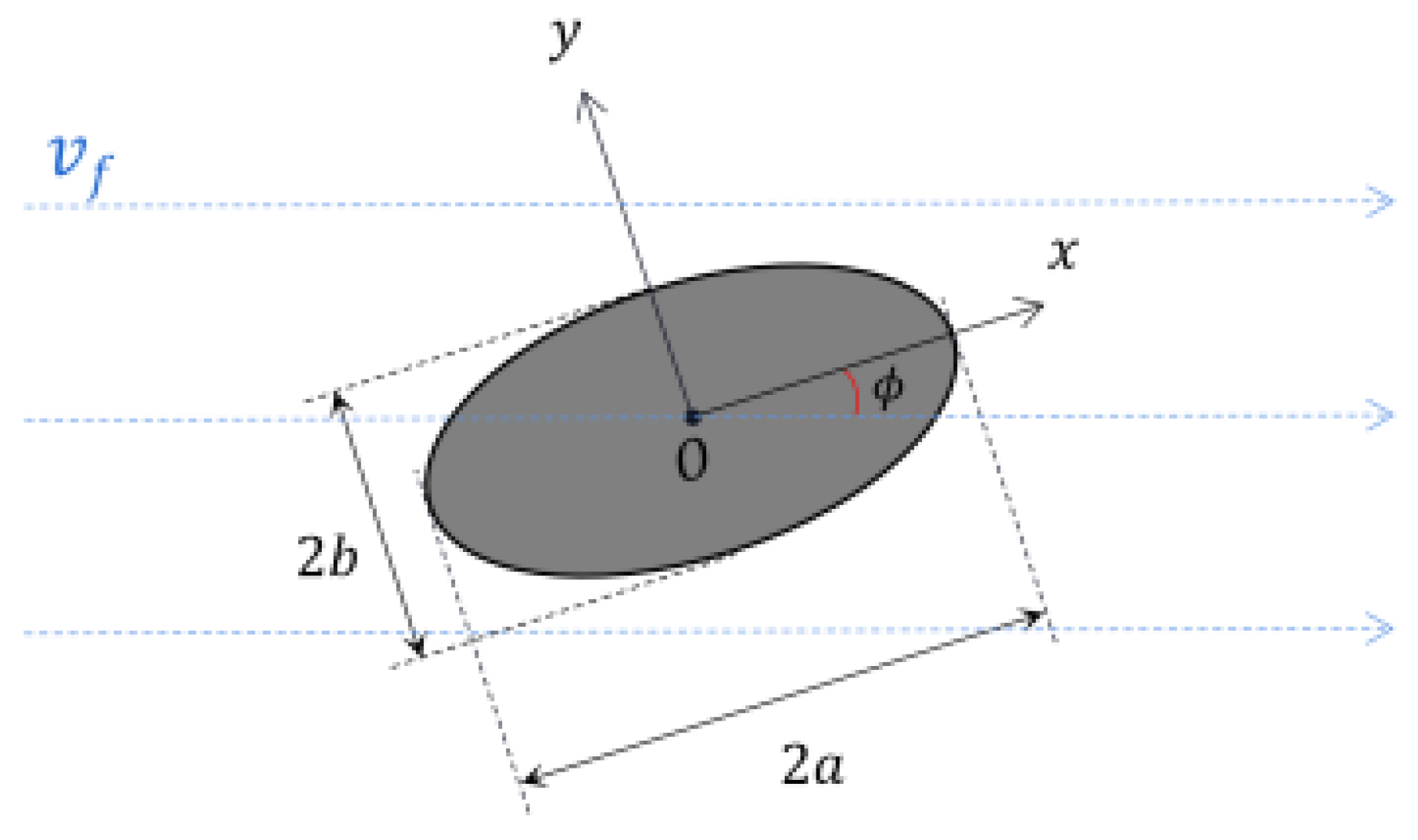
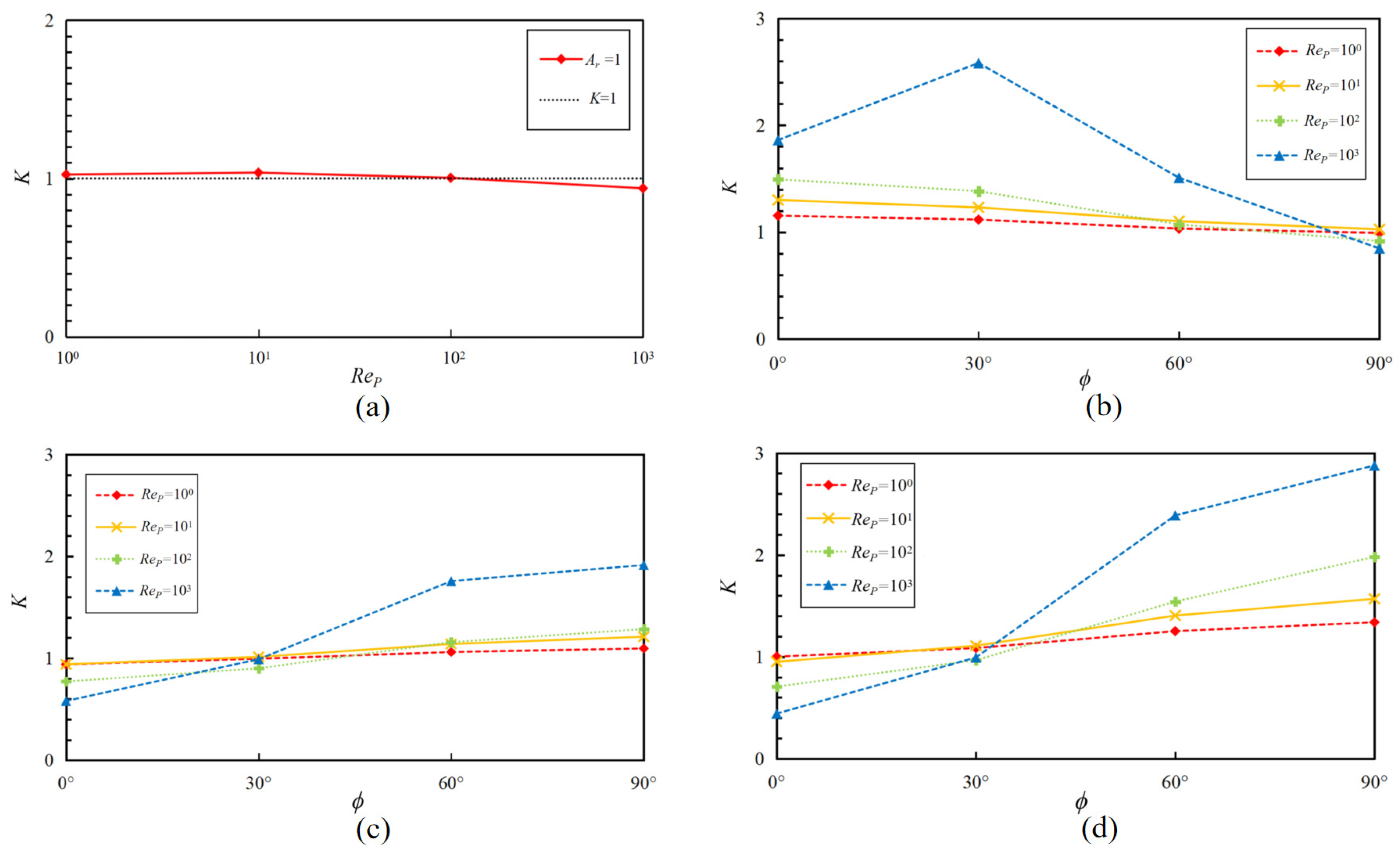
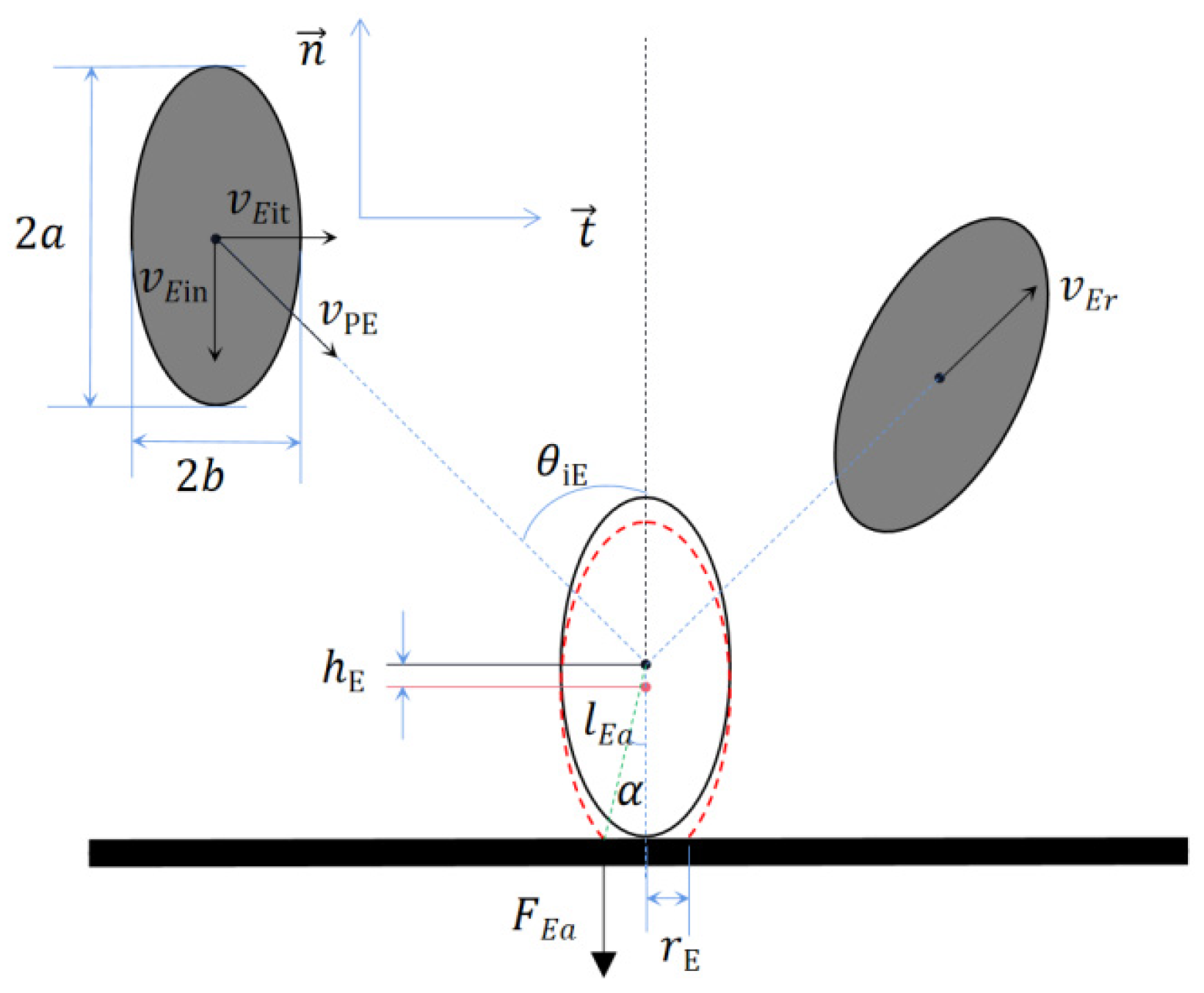

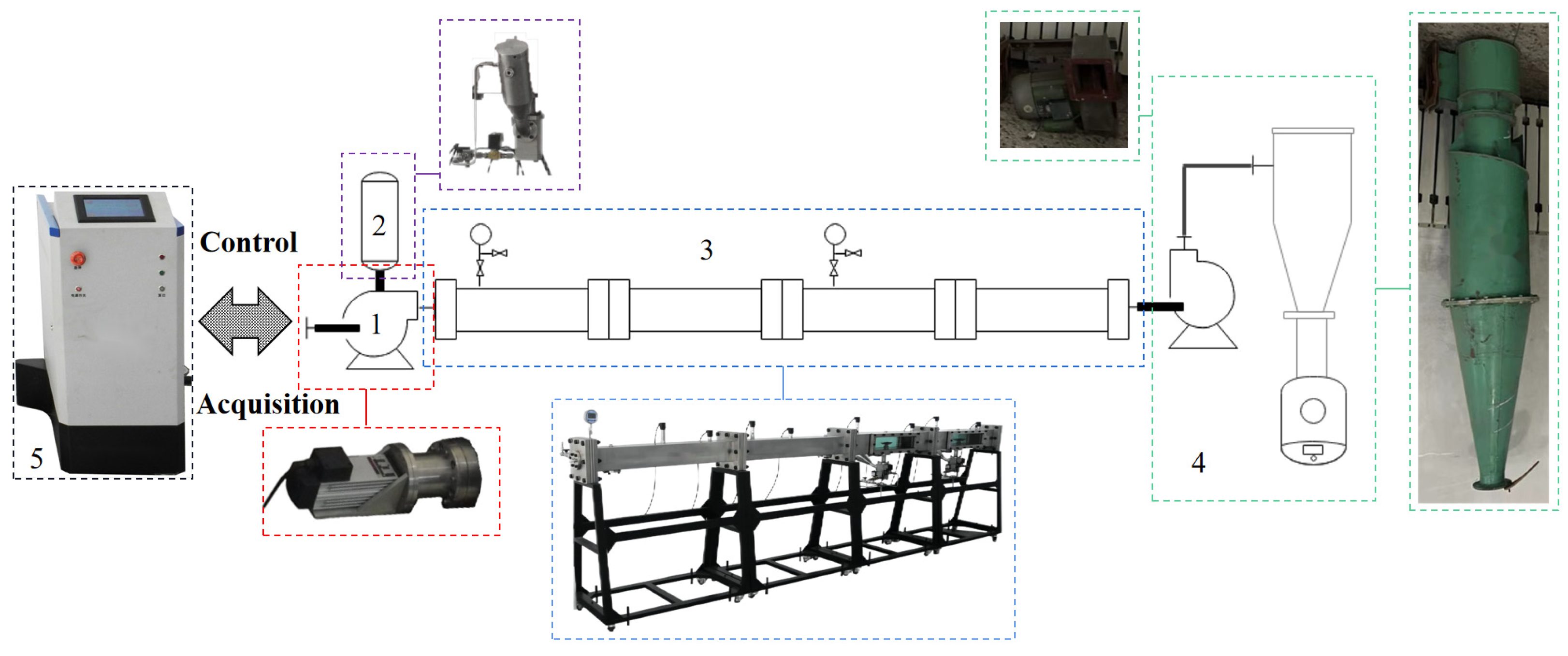

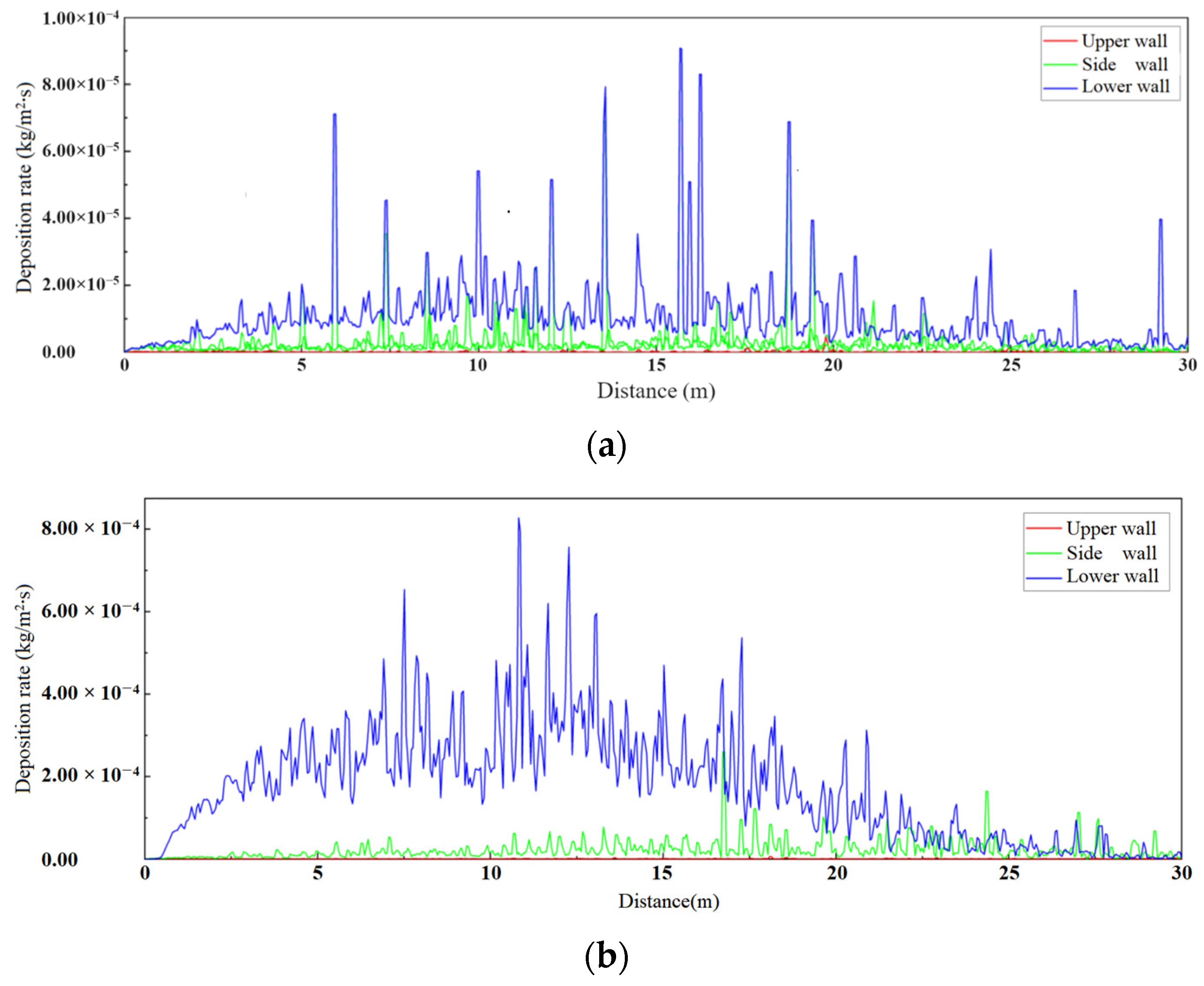

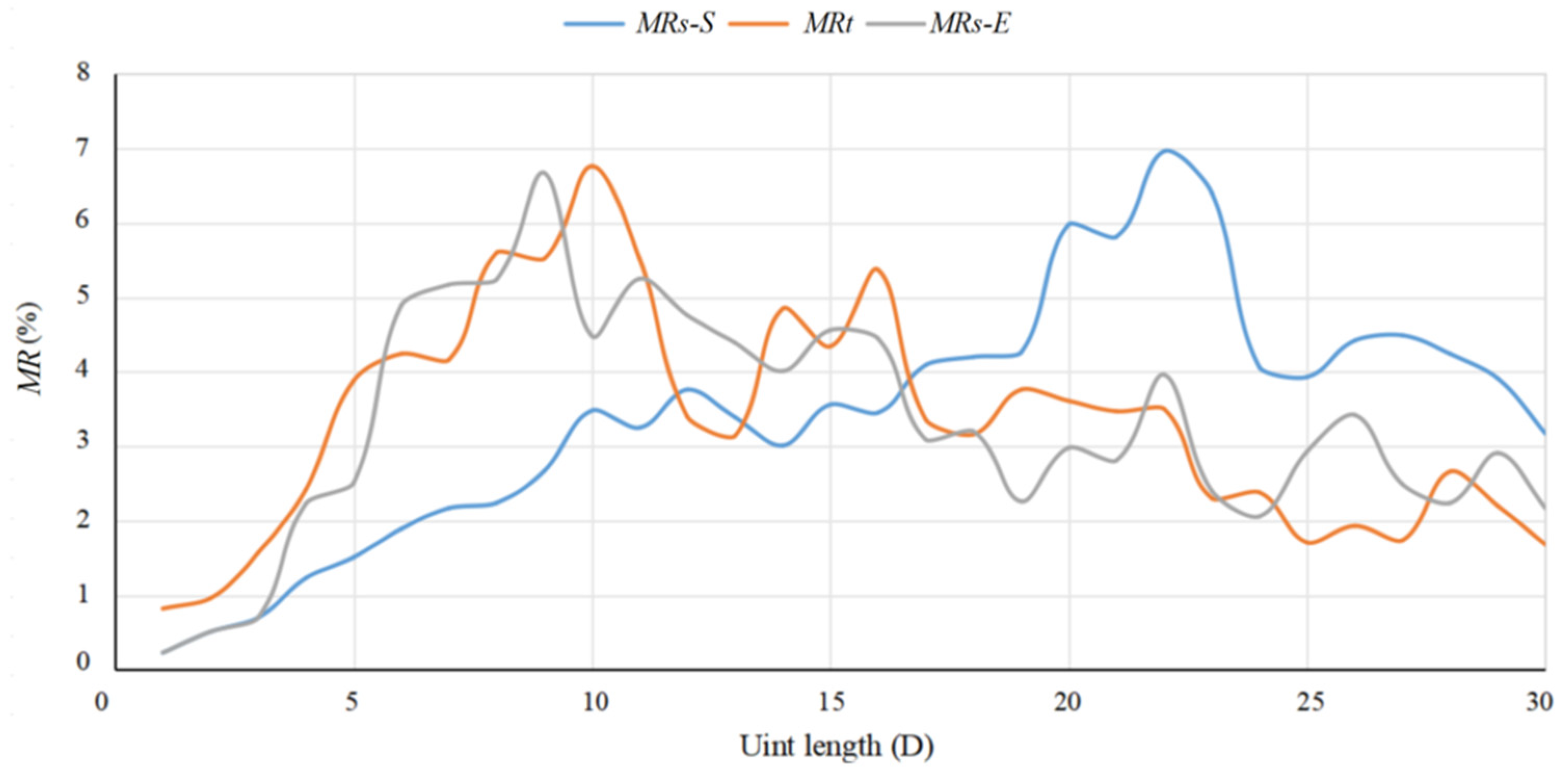
| Parameter Class | Value | |||
|---|---|---|---|---|
| Length-diameter ratio | 0.5 | 1 | 2 | 4 |
| Angle of incoming flow | 0° | 30° | 60° | 90° |
| Reynolds number | 100 | 101 | 102 | 103 |
| Length-Diameter Ratio | Angle of Incoming Flow | Reynolds Number | |||
|---|---|---|---|---|---|
| = 100 | = 101 | = 102 | = 103 | ||
| = 0.5 | = 0° | 1.154 | 1.301 | 1.494 | 1.862 |
| = 30° | 1.117 | 1.231 | 1.384 | 2.584 | |
| = 60° | 1.033 | 1.102 | 1.072 | 1.509 | |
| = 90° | 0.992 | 1.026 | 0.916 | 0.847 | |
| = 1 | = 0° | 1.025 | 1.037 | 1.004 | 0.938 |
| = 2 | = 0° | 0.940 | 0.941 | 0.772 | 0.581 |
| = 30° | 0.995 | 1.013 | 0.901 | 0.990 | |
| = 60° | 1.061 | 1.140 | 1.158 | 1.757 | |
| = 90° | 1.096 | 1.211 | 1.286 | 1.915 | |
| = 4 | = 0° | 1.002 | 0.951 | 0.708 | 0.443 |
| = 30° | 1.086 | 1.109 | 0.967 | 0.994 | |
| = 60° | 1.252 | 1.405 | 1.542 | 2.388 | |
| = 90° | 1.339 | 1.569 | 1.981 | 2.878 | |
| Name | Size | Composition | Purity | Density | Product Batch Number |
|---|---|---|---|---|---|
| Spherical silica particles | 40 μm | SiO2 | 9.99% | 2.32 g/cm3 | KG-22 |
| Nominal Particle Size (μm) | D(50) (μm) | D(10) (μm) | D(25) (μm) | D(75) (μm) | D(90) (μm) | D(4,3) (μm) | D(3,2) (μm) |
|---|---|---|---|---|---|---|---|
| 40 | 41.464 | 13.621 | 22.942 | 67.704 | 90.844 | 46.372 | 24.013 |
Disclaimer/Publisher’s Note: The statements, opinions and data contained in all publications are solely those of the individual author(s) and contributor(s) and not of MDPI and/or the editor(s). MDPI and/or the editor(s) disclaim responsibility for any injury to people or property resulting from any ideas, methods, instructions or products referred to in the content. |
© 2024 by the authors. Licensee MDPI, Basel, Switzerland. This article is an open access article distributed under the terms and conditions of the Creative Commons Attribution (CC BY) license (https://creativecommons.org/licenses/by/4.0/).
Share and Cite
Niu, C.; Zhou, Z.; Qi, J.; Yang, X. Simulation and Experimental Verification of Pipeline Particle Deposition Based on Ellipsoidal Assumption. Processes 2024, 12, 1610. https://doi.org/10.3390/pr12081610
Niu C, Zhou Z, Qi J, Yang X. Simulation and Experimental Verification of Pipeline Particle Deposition Based on Ellipsoidal Assumption. Processes. 2024; 12(8):1610. https://doi.org/10.3390/pr12081610
Chicago/Turabian StyleNiu, Chenchen, Zhen Zhou, Jia Qi, and Xu Yang. 2024. "Simulation and Experimental Verification of Pipeline Particle Deposition Based on Ellipsoidal Assumption" Processes 12, no. 8: 1610. https://doi.org/10.3390/pr12081610




